Cyber threats to businesses in 2025
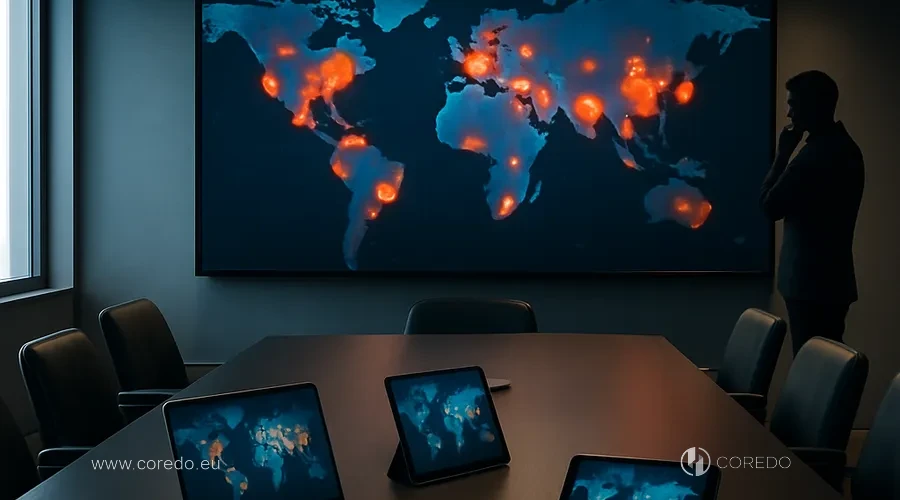
Cyber threats to businesses in the EU, Asia and Africa
Over the past three years the COREDO team has completed more than 120 cyber threat protection projects for clients from the Czech Republic, Estonia, Singapore and Dubai. We observe that cyberattacks on businesses are becoming increasingly complex: attackers use artificial intelligence to automate attacks, and social engineering is becoming the primary tool for breaching corporate networks.
COREDO’s practice confirms: a company’s digital traces — from corporate email to cloud services — are often used by hackers to prepare targeted attacks. In one case, while working with a holding company in the EU, we found that more than 40% of vulnerabilities arose because contractors had uncontrolled access to internal systems. The solution developed by COREDO included implementing the principle of least privilege and regular vulnerability assessments (vulnerability assessment).
Cybersecurity in 2025 for businesses
In 2025 corporate cybersecurity will be built around the concepts of employees’ digital hygiene and digital identity. Cybercrime in the B2B sector is shifting toward attacks on trust and reputation, for example through phishing campaigns that mimic business correspondence. International regulators are tightening data protection requirements (GDPR, NIS2, DORA), and fines for cybersecurity breaches in the EU can reach 4% of annual turnover.
In a case with a fintech company from the United Kingdom, we helped build a digital identity system by integrating multi-factor authentication (MFA) and automated corporate email filtering, which reduced the number of successful phishing attacks by 60%.
Cybersecurity strategies for business
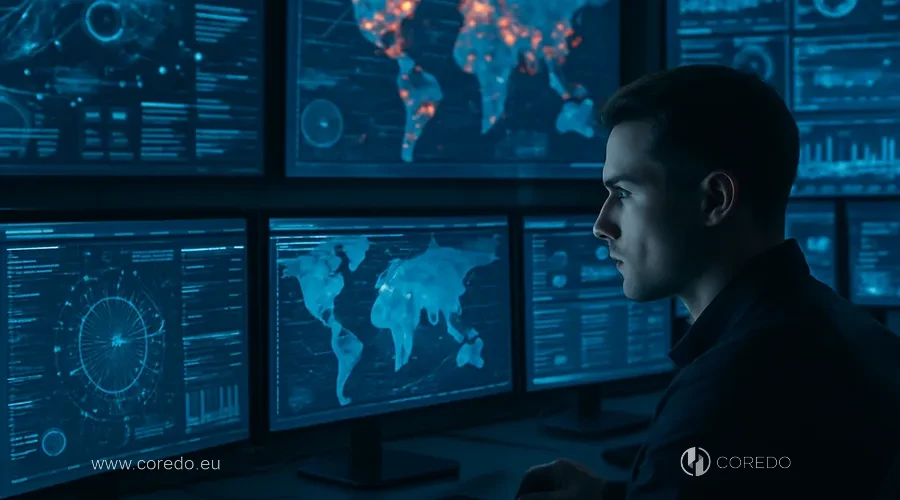
Cybersecurity strategies for business today are becoming a necessary foundation for maintaining competitiveness and preventing critical losses. In a rapidly changing IT environment and under pressure from new threats, it is important for companies not only to respond promptly to risks, but also to systematically implement modern protection practices that take into account the specifics of their business.
Cyber risk management — how to reduce threats?
This approach helps minimize losses during incidents and accelerates the recovery of business processes. In a project for a holding with branches in the EU and Asia we implemented digital change management, which made it possible to respond promptly to new threats and integrate best practices from different jurisdictions.
Turning to data protection, let’s look at how a multilayer Zero Trust strategy ensures the continuous security of the company’s digital assets.
Multilayer Zero Trust data protection
The solution developed at COREDO includes implementing Zero Trust: every access to data is verified regardless of source, and access control is built on the principle of least privilege. To prevent data loss (DLP) we integrate monitoring tools and automated policies, which is especially important for companies working with intellectual property.
In the case of a fintech startup in Singapore we conducted a security assessment (pentest) and simulated phishing attacks, identifying weak points in employees’ digital identities. As a result of implementing Zero Trust and regular testing, the security level increased by 35%.
Cloud and mobile device security
Cloud technology security and mobile device protection in business: key challenges for international companies. Our experience at COREDO has shown: effective mobile device management (MDM) and digital management of contractors and third parties can reduce the risks of data leakage when working with cloud services.
In a project for a group of companies in Dubai we implemented digital incident management and 3-2-1 backup, which ensured business continuity even in the event of a mass cyberattack on the cloud infrastructure.
Corporate cybersecurity tools
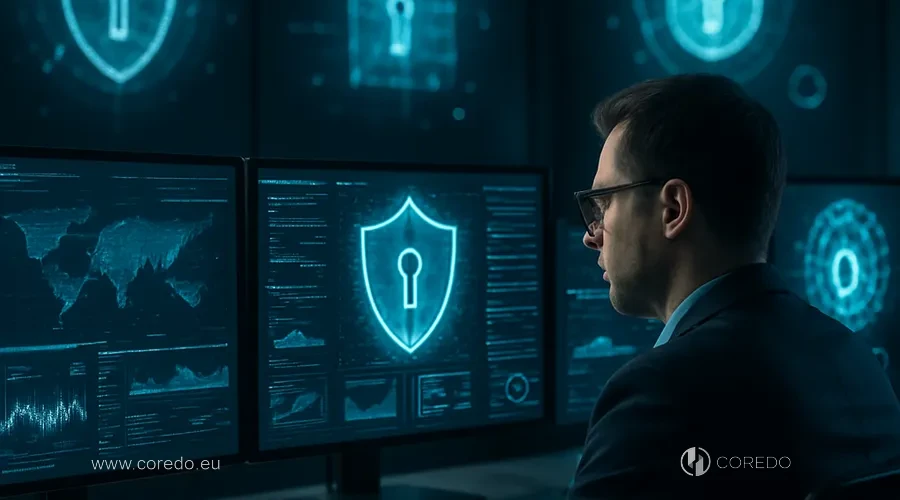
Corporate cybersecurity tools are a set of solutions that help organizations detect and prevent threats, as well as respond effectively to incidents. To ensure a high level of protection, companies apply specialized approaches, among which regular audits, penetration testing and vulnerability scanning play an important role.
Security audit: penetration testing and vulnerabilities
Security analysis (pentest) and vulnerability assessment are mandatory steps for entering new EU and Asian markets. The COREDO team conducts digital penetration testing using international standards (OWASP, ISO 27001) and integrates security information and event management (SIEM) for continuous monitoring.
Thus, comprehensive cyber protection is impossible without the implementation of modern tools for threat monitoring and prevention.
XDR, SOC, DLP, IPS, WAF – cybersecurity tools
Extended detection and response (XDR), integrated SOCs (Security Operations Center), intrusion prevention systems (IPS) and web application firewalls (WAF): key technologies for automating incident response. At COREDO we deploy DLP to prevent data leakage and automate incident response, which is especially relevant for large international companies.
In the table below I compare XDR and SASE for medium-sized businesses:
| Criterion | XDR (Extended Detection & Response) | SASE (Secure Access Service Edge) |
|---|---|---|
| Purpose | Advanced detection and threat response | Integration of network and cloud security |
| Applicability | Medium and large companies | Companies with distributed infrastructure |
| Key advantages | Centralized monitoring, automated incident response | Flexibility, scalability, cloud protection and protection for remote employees |
| Drawbacks | Requires integration with SOC, high cost | Implementation complexity, dependence on provider |
In COREDO’s case for a holding company in the Czech Republic, implementing XDR reduced incident response time from 12 hours to 30 minutes.
Automation and AI in cybersecurity
COREDO’s experience shows that digital threat analytics (threat intelligence) and the implementation of automated response scenarios enable staying ahead of attackers and minimizing the human factor in information security.
In a project for an international holding company we integrated SIEM with an AI module, which allowed us to detect anomalies in user behavior and prevent insider threats.
Corporate Cybersecurity Culture
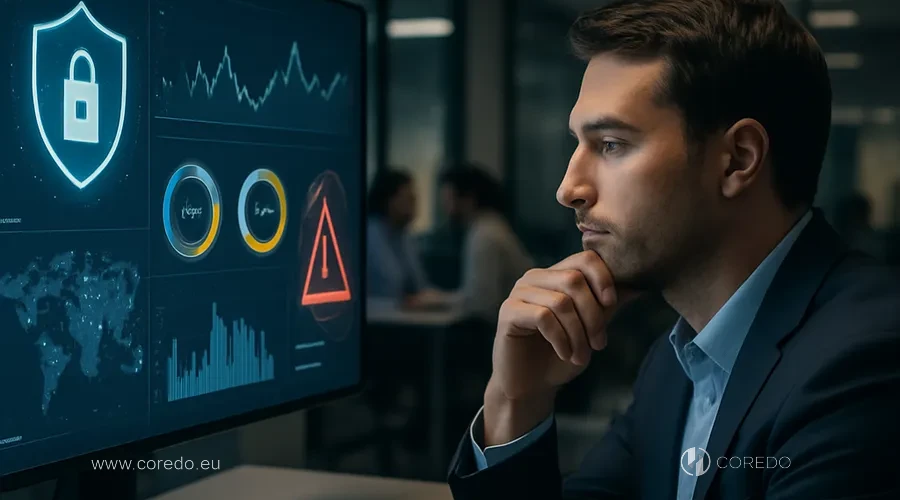
Corporate cybersecurity culture forms the foundation on which employee behavior and the team’s attitude toward data protection are built. Conscious implementation of these principles helps not only to reduce the number of incidents but also to make security part of each employee’s daily work.
Employee training and incident simulations
Training employees in cyber hygiene and simulating incidents for training are the basis of corporate cybersecurity culture. The solution developed at COREDO includes digital training and upskilling, regular phishing attack simulations, and analysis of employees’ digital hygiene.
How to limit user privileges on the site
Access management based on the principle of least privilege, multi-factor authentication (MFA), and a well-designed password management policy: critical elements for protecting digital identities and corporate data. At COREDO we implement digital contractor management, which allows control over third-party access to key business processes.
In a case for a fintech company in Slovakia, MFA integration and regular password audits completely eliminated successful attacks using stolen credentials.
Financial and Legal Risks of Cybersecurity
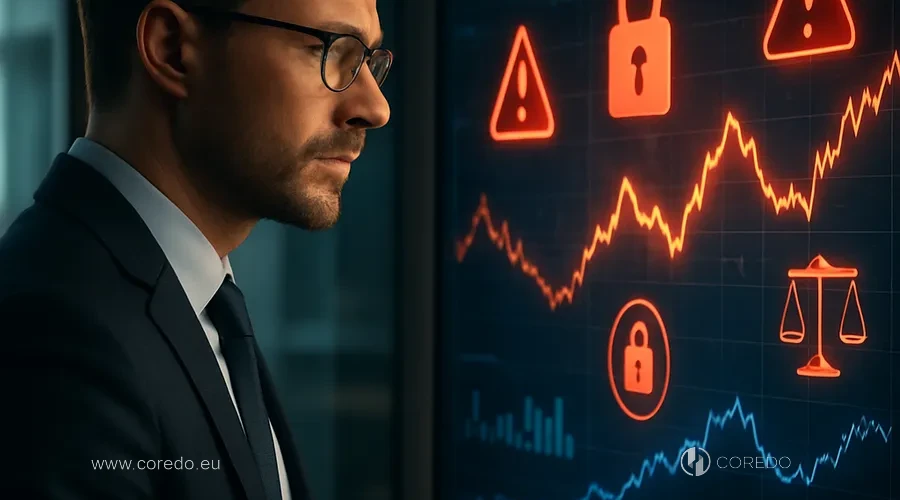
Being able to assess and manage these risks rationally becomes a key factor in maintaining the company’s long-term financial resilience. Rational investments in information security require not only risk assessment but also an understanding of their financial returns; we will consider this approach below.
How to Calculate Cybersecurity ROI
Cybersecurity budgeting and assessing return on investment (ROI) are questions clients regularly ask COREDO. We recommend using digital protection performance metrics (KPI, ROI), taking into account the assessment of cyber risk costs and the potential of the business’s digital resilience.
In a case for a holding company with branches in the EU, the COREDO team helped justify the cybersecurity budget to the board of directors using a damage assessment model and incident development scenarios.
Cyber Insurance in Risk Management
Business cyber insurance and digital risk insurance are becoming standard for international companies. At COREDO we integrate cyber insurance into the overall risk management strategy, taking into account digital diversification and the specifics of working with contractors.
In a project for a group of companies in Asia, we implemented digital incident management, which reduced insurance premiums and increased the business’s economic resilience.
Regulatory Requirements in the EU, Asia, and Africa
Compliance with regulatory requirements (compliance) is a mandatory condition for operating in the EU, Asia, and African markets. The COREDO team supports clients on digital compliance issues, helping to integrate the requirements of GDPR, NIS2, DORA and avoid fines for cybersecurity breaches.
In a case for a fintech company in Estonia, we implemented digital change management, which allowed the regulatory audit to be completed without findings.
Information security outsourcing and vCISO – what is it?
Information security outsourcing and vCISO services: these are modern approaches to managing and protecting a company’s digital assets without the need to maintain an in-house team of specialists. This format not only reduces costs but also provides access to the expertise of professionals who are ready to take on all key tasks to ensure the information security of the business.
In-house department or outsourcing, which to choose?
The choice between an in-house IS department and outsourcing (vCISO) is becoming increasingly relevant for international companies. COREDO’s experience shows: digital security outsourcing enables rapid scaling of protection measures, integration of DevSecOps best practices, and reduced costs for maintaining an in-house SOC.
In a case for a holding company in Singapore, we helped establish digital contractor management, which ensured flexibility and prompt incident response.
How to choose a vCISO for international business
When choosing a vCISO, it is important to consider experience with digital regulatory requirements, the ability to integrate digital change management, and readiness to work with distributed teams. The solution developed by COREDO includes digital management of contractors and third parties, allowing risks to be controlled at all stages of business processes.
Protecting your business from cyber threats: steps and tips
Reliable business protection from cyber threats is not just a formality today, but a matter of survival for companies of any size. The following steps and practical cybersecurity tips will help identify vulnerabilities and create an effective strategy, minimizing risks to your business.
Cybersecurity measures for business
- Assessing the organization’s digital maturity and regular cybersecurity audits.
- Implementing multi-layered data protection and Zero Trust.
- Organizing employee training in cyber hygiene and incident simulations.
- Integration of XDR, SOC, DLP, MFA, and incident response automation.
- Ensuring digital business continuity and backups following the 3-2-1 rule.
- Controlling contractor access and managing the company’s digital footprint.
- Compliance with regulatory requirements (GDPR, NIS2, DORA) and integration of digital compliance.
Key recommendations for businesses
COREDO’s expert experience shows: business cybersecurity is not only about technology, but also corporate culture, financial planning, and legal literacy. A company’s information security is built on principles of digital maturity, resilience, and continuous development. Those who invest in cybersecurity strategies today will gain not only protection but also a competitive advantage tomorrow.